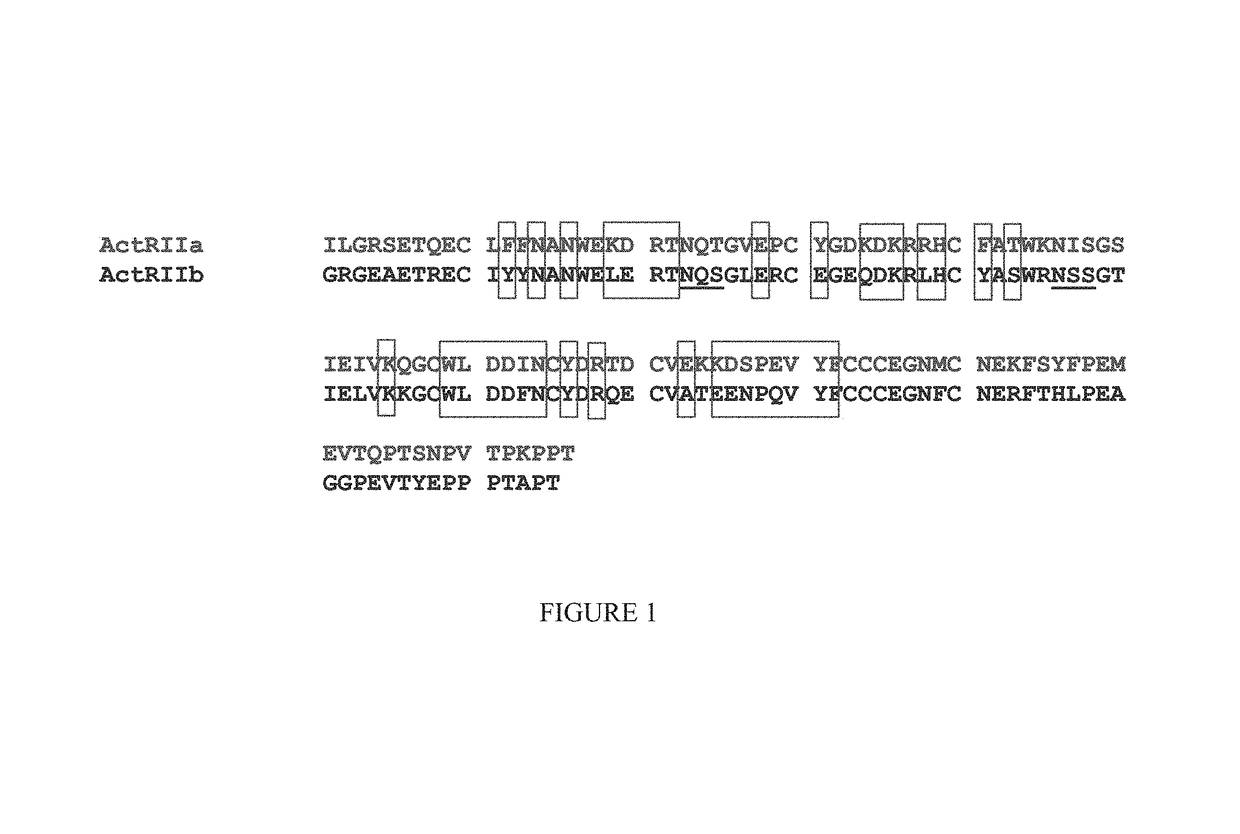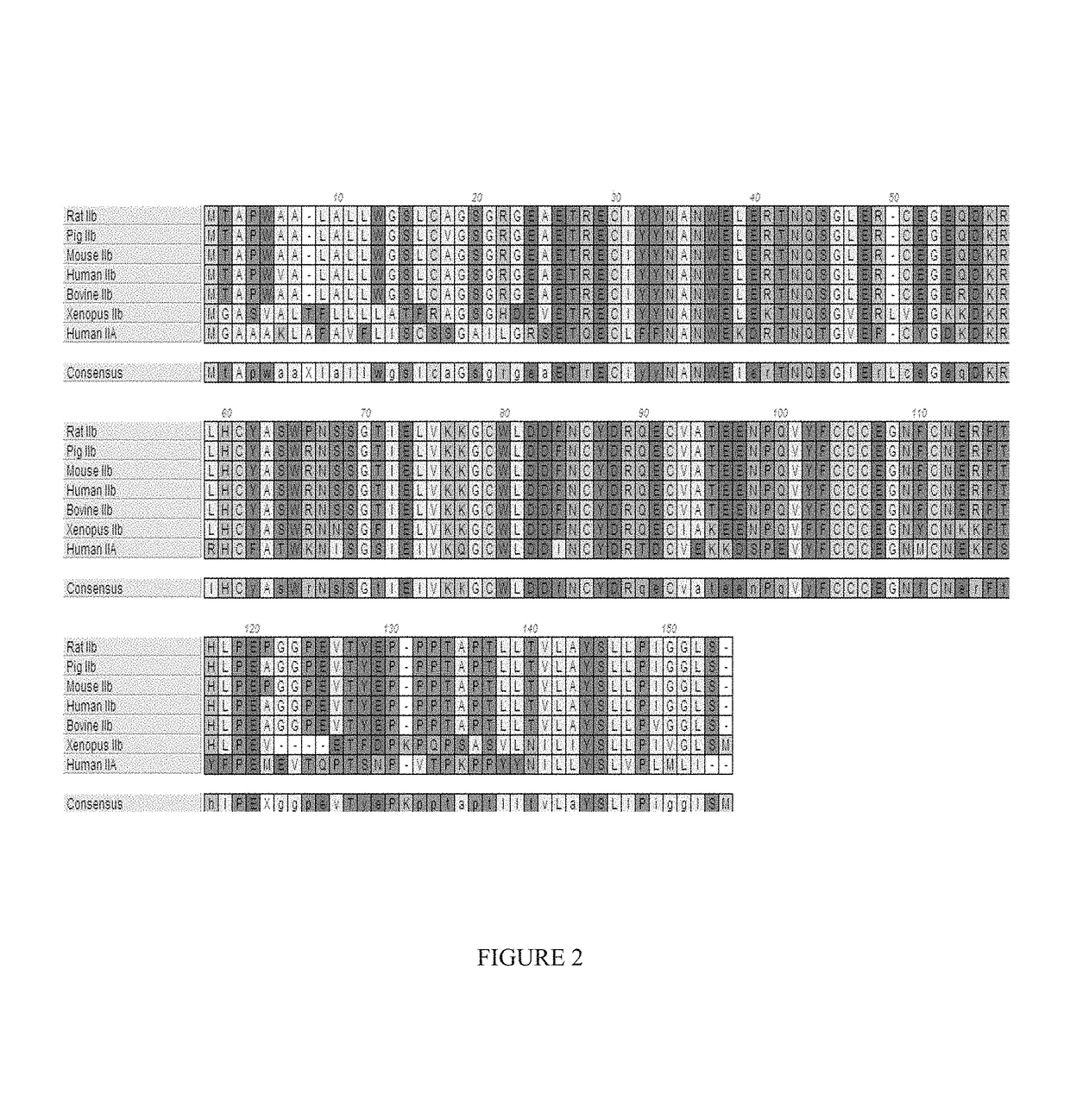Methods for treating myelodysplastic syndromes and sideroblastic anemias
a myelodysplastic syndrome and sideroblastic anemia technology, applied in the direction of drug compositions, extracellular fluid disorders, peptide/protein ingredients, etc., can solve the problems of poor therapeutic response, many individuals are refractory to even high doses, and the efficacy of epo is not uniform, so as to increase the production of endogenous epo and improve the effect of erythropoietic function
- Summary
- Abstract
- Description
- Claims
- Application Information
AI Technical Summary
Benefits of technology
Problems solved by technology
Method used
Image
Examples
example 1
c Fusion Proteins
[0383]Applicants constructed a soluble ActRIIA fusion protein that has the extracellular domain of human ActRIIa fused to a human or mouse Fc domain with a minimal linker in between. The constructs are referred to as ActRIIA-hFc and ActRIIA-mFc, respectively.
[0384]ActRIIA-hFc is shown below as purified from CHO cell lines (SEQ ID NO:22):
[0385]
ILGRSETQECLFFNANWEKDRTNQTGVEPCYGDKDKRRHCFATWKNISGSIEIVKQGCWLDDINCYDRTDCVEKKDSPEVYFCCCEGNMCNEKFSYFPEMEVTQPTSNPVTPKPPTGGGTHTCPPCPAPELLGGPSVFLFPPKPKDTLMI
[0386]The ActRIIA-hFc and ActRIIA-mFc proteins were expressed in CHO cell lines. Three different leader sequences were considered:[0387](i) Honey bee mellitin (HBML): MKFLVNVALVFMVVYISYIYA (SEQ ID NO:23)[0388](ii) Tissue plasminogen activator (TPA): MDAMKRGLCCVLLLCGAVFVSP (SEQ ID NO:24)[0389](iii) Native: MGAAAKLAFAVFLISCSSGA (SEQ ID NO:25).
[0390]The selected form employs the TPA leader and has the following unprocessed amino acid sequence:
[0391]
(SEQ ID NO: 26)MDAMKRGLCCVLLLCGAVFV...
example 2
ization of an ActRIIA-hFc Protein
[0397]ActRIIA-hFc fusion protein was expressed in stably transfected CHO-DUKX B11 cells from a pAID4 vector (SV40 ori / enhancer, CMV promoter), using a tissue plasminogen leader sequence of SEQ ID NO:9. The protein, purified as described above in Example 1, had a sequence of SEQ ID NO:22. The Fc portion is a human IgG1 Fc sequence, as shown in SEQ ID NO:22. Protein analysis reveals that the ActRIIA-hFc fusion protein is formed as a homodimer with disulfide bonding.
[0398]The CHO-cell-expressed material has a higher affinity for activin B ligand than that reported for an ActRIIa-hFc fusion protein expressed in human 293 cells [see, del Re et al. (2004) J Biol Chem. 279(51):53126-53135]. Additionally, the use of the TPA leader sequence provided greater production than other leader sequences and, unlike ActRIIA-Fc expressed with a native leader, provided a highly pure N-terminal sequence. Use of the native leader sequence resulted in two major species of ...
example 3
Fc Increases Red Blood Cell Levels in Non-Human Primates
[0399]The study employed four groups of five male and five female cynomolgus monkeys each, with three per sex per group scheduled for termination on Day 29, and two per sex per group scheduled for termination on Day 57. Each animal was administered the vehicle (Group 1) or ActRIIA-Fc at doses of 1, 10, or 30 mg / kg (Groups 2, 3 and 4, respectively) via intravenous (IV) injection on Days 1, 8, 15, and 22. The dose volume was maintained at 3 mL / kg. Various measures of red blood cell levels were assessed two days prior to the first administration and at days 15, 29, and 57 (for the remaining two animals) after the first administration.
[0400]The ActRIIA-hFc caused statistically significant increases in mean red blood cell parameters [red blood cell count (RBC), hemoglobin (HGB), and hematocrit (HCT)] for males and females, at all dose levels and time points throughout the study, with accompanying elevations in absolute and relative ...
PUM
| Property | Measurement | Unit |
|---|---|---|
| time | aaaaa | aaaaa |
| time | aaaaa | aaaaa |
Abstract
Description
Claims
Application Information
 Login to View More
Login to View More - R&D
- Intellectual Property
- Life Sciences
- Materials
- Tech Scout
- Unparalleled Data Quality
- Higher Quality Content
- 60% Fewer Hallucinations
Browse by: Latest US Patents, China's latest patents, Technical Efficacy Thesaurus, Application Domain, Technology Topic, Popular Technical Reports.
© 2025 PatSnap. All rights reserved.Legal|Privacy policy|Modern Slavery Act Transparency Statement|Sitemap|About US| Contact US: help@patsnap.com



